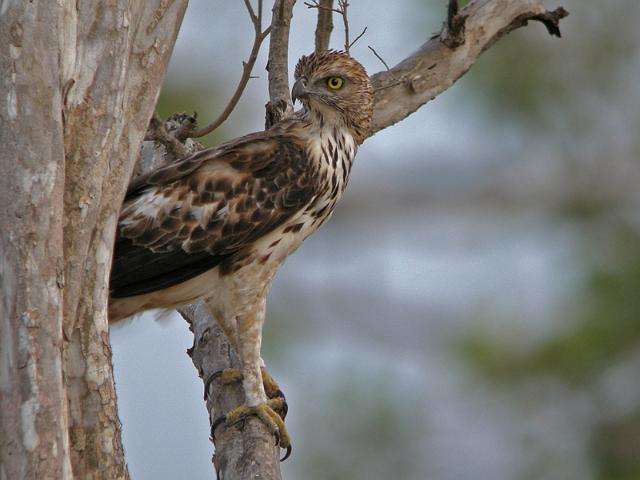Circaetus gallicus
IUCN
LCBasic Information
Scientific classification
- name:Circaetus gallicus
- Scientific Name:Circaetus gallicus,Short-toed Snake-Eagle,Accipiter ferox,Circaetus ferox,Circaetus gallicus ferox,Circaetus gallicus gallicus,Circaetus gallicus heptneri,Circaetus gallicus hypoleucos,Circaetus hypol
- Outline:Raptor
- Family:Falconiformes Accipitridae S.subfamily B.genus
Vital signs
- length:62-70cm
- Weight:1.2-2.3kg
- lifetime:20-70years
Feature
Usually silent in winter, with occasional plaintive meowing
Distribution and Habitat
Origin: Afghanistan, Albania, Algeria, Andorra, Armenia, Azerbaijan, Bahrain, Bangladesh, Belarus, Benin, Bosnia and Herzegovina, Bulgaria, Burkina Faso, Cameroon, Central African Republic, Chad, China, Democratic Republic of the Congo, Côte d'Ivoire, Croatia, Czech Republic, Djibouti, Egypt, Estonia, Ethiopia, France, Gambia, Georgia, Ghana, Gibraltar, Greece, Guinea, Guinea-Bissau, Hungary, India, Indonesia, Islamic Republic of Iran, Iraq, Israel, Italy, Jordan, Kazakhstan, Kenya, Kuwait, Kyrgyzstan, Latvia, Lebanon, Liberia, Bahrain, Lithuania, Macedonia, Mali, Mauritania, Moldova, Montenegro, Morocco, Myanmar, Nepal, Niger, Nigeria, Oman, Pakistan, Palestine, Poland, Portugal, Qatar, Romania, Russian Federation (Central Asia and Europe), Saudi Arabia, Senegal, Serbia, Singapore, Slovakia, Slovenia, Somalia, South Sudan, Spain, Sudan, Switzerland, Syrian Arab Republic, Tajikistan, United Republic of Tanzania, Thailand, East Timor, Togo, Tunisia, Turkey, Turkmenistan, Uganda, Uk
Appearance
The body length is 62-70 cm, the bill is 4.0-4.3 cm, the wingspan is 17-20 cm, and the tail is 25.2-28.8 cm; the male weighs 1.2-2 kg, and the female weighs 1.3-2.3 kg. It is a snake-eating eagle similar to the white-bellied sea eagle, white-bellied falcon eagle, and osprey, but the throat and chest are sandy brown with rusty vertical stripes, and the abdomen has sandy brown horizontal stripes; the tail feathers are longer. This species can be distinguished from the West African short-toed eagle and black-breasted short-toed eagle of the same genus. They can be identified on the ground from their white inner wings and gray-brown lower body. The upper body is sandy brown or gray-brown, the head is relatively round, the eyes are large, the top of the head, the back of the neck and the upper back have long lanceolate feathers and black-brown feather shaft patterns, and the front of the eyes, forehead, cheeks, eyebrow stripes and under the eyes are white. The longest shoulder feathers are
Details
Short-toed Snake-Eagle, also known as Short-toed Snake-Eagle in English, is a large bird of prey with 4 subspecies.

The short-toed eagle is extremely rare in all parts of China. It is a breeding bird in Xinjiang, a winter migratory bird in Gansu, and an occasional migratory bird in Beijing, Liaoning, and Hebei. It was discovered in Shaanxi in the 1960s, but there have been no new reports since then. It migrates to the breeding grounds from early to mid-April and leaves the breeding grounds in October-November.
Short-toed eagles often act alone. They are often seen soaring and gliding in the air, with their wings stretched out. They mainly forage by soaring in the air for a long time to search, and then suddenly descend to catch after finding something. They need to build nests in trees.
Short-toed eagles are also called short-toed snake eagles. As its name suggests, short-toed eagles mainly feed on snakes, which can be up to 150 cm or longer. They eat the snake heads first and usually finish them. Some of these snakes are poisonous species, but most are non-toxic. Other reptiles are also on the menu, especially lizards, and occasionally amphibians, small mammals (such as hares and wild mice), birds or invertebrates, and also eat carrion. Most hunting takes place in open areas.
The breeding season of the short-toed eagle is from April to June. Most of them nest in the forest edge area, on the top branches of the tree, generally 2-15 meters above the ground, and occasionally on the cliff. The nest is made of dead branches, with an outer diameter of 68-136 cm, an inner diameter of 35-55 cm, and a height of 60-100 cm. If there is no interference, the nest can be used for many years. Each nest usually lays 1 egg, occasionally 2 eggs, the color of the egg is white, and the size is 6.7-8.0×5.0-6.4 cm. The eggs are mainly incubated by the female bird. The incubation period is 47 days. The chicks are late-maturing, and they are fed by the parents for about 70-75 days after hatching before they can leave the nest.
The Short-toed Eagle suffered a significant decline in northern Europe from the 19th to the 20th century due to habitat loss and persecution (Snow and Perrins 1998, Ferguson-Lees and Christie 2001). In Europe, agricultural clearing and land use changes have reduced the range of suitable hunting habitats for the Short-toed Eagle. In addition, increased plant cultivation and hedgerow destruction, pesticide use and abandonment of traditional farmland and subsequent afforestation have reduced the number of snake species. Habitat fragmentation caused by forest fires and road construction in Europe. It is still subject to shooting in Malta (del Hoyo et al 1994). Threats caused by nest destruction and power lines (Tucker and Heath 1994). The species is also highly vulnerable to potential wind energy development (Strix 2012). Within its range in West Africa, the species is susceptible to habitat degradation through timber harvesting and overgrazing, as well as exposure to pesticides (Thiollay 2007).
Listed in the IUCN Red List of Threatened Species in 2016 ver 3.1 - Least Concern (LC).
Listed in the Appendix II of the Washington Convention on International Trade in Endangered Species (CITES).
Listed in the second level of China's National List of Key Protected Wildlife (February 5, 2021).
Protect wild animals and stop eating game.
Maintaining ecological balance is everyone's responsibility!








